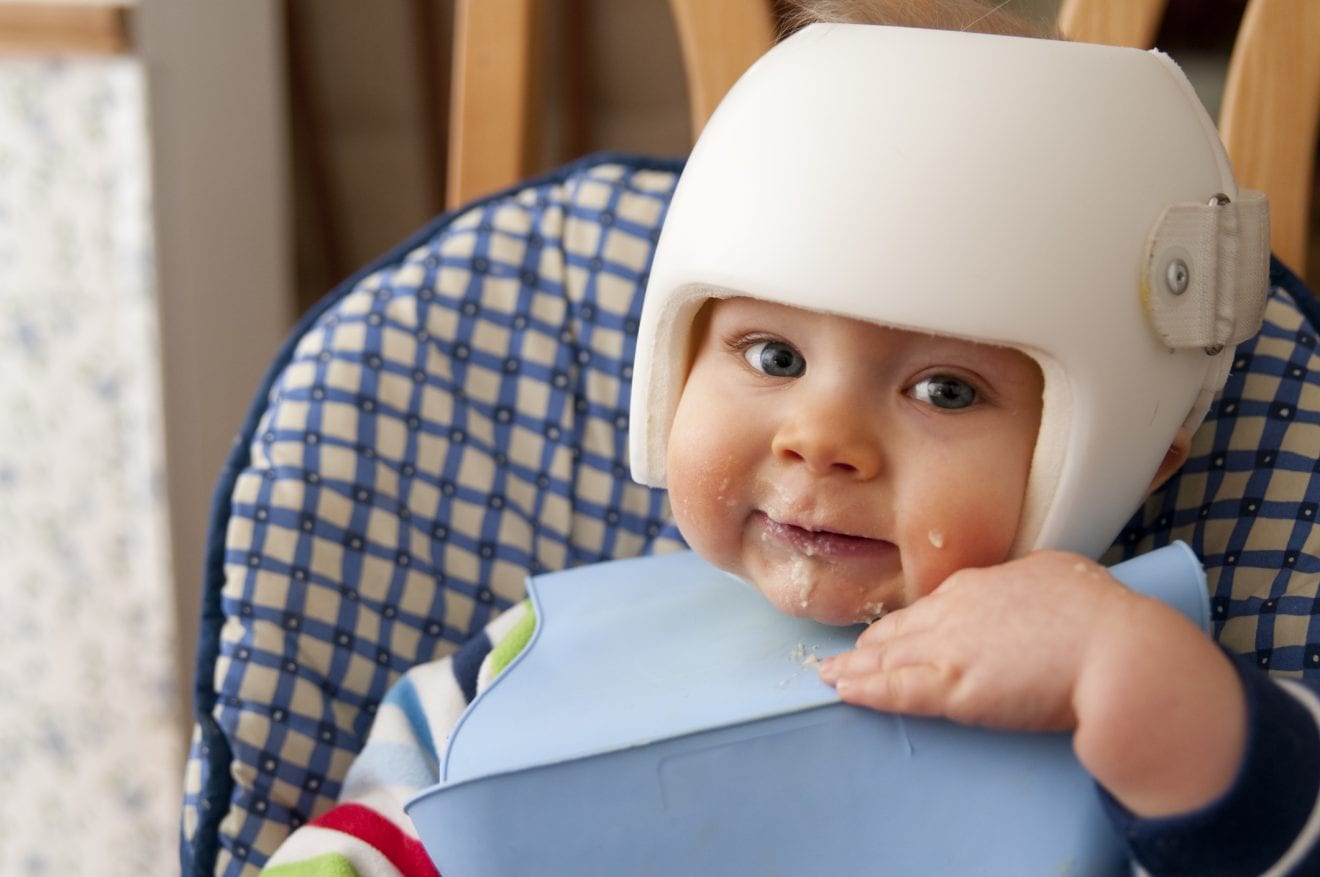I think there is nothing cuter than a baby in a helmet! But if we can prevent the need for one, we should probably go that route. Plagiocephaly, or flat head syndrome, is caused when there is repeated pressure on one spot of a baby’s skull, often leading to the need for a corrective helmet. It is common, but luckily, it is also very treatable.1 In this article, we’ll explore everything you need to know about plagiocephaly.
What Is Plagiocephaly?
Plagiocephaly, often called positional plagiocephaly, occurs from a baby’s positioning in utero or positioning after birth.1 Because newborn babies have a malleable skull (meaning they have soft spots and bones that are not entirely fused yet), the skull can form into shapes other than round fairly easily.5 The purpose of the malleable skull is to allow for growth and to allow the baby through the birth canal.5,6 Your baby’s brain will double in weight in one year due to new synapses between neurons if they get plenty of stimulation.7 The unfused skull allows for this growth and a misshapen head when too much pressure is on one specific area.1,2

The best way to assess the shape of your baby’s head is to look at it from the top. And fortunately, plagiocephaly does not usually affect the child’s mental development, as the brain is very protected.5
Additionally, don’t be alarmed if their head is the shape of a cone when they are born vaginally. It is not plagiocephaly — instead, it is due to the pressure of the birth canal. This will typically resolve within a few days or weeks at the most.8
What Is Torticollis?

Babies with plagiocephaly may have a secondary condition called torticollis. This is a tightness of one side of your baby’s neck muscles.5 The position in utero often causes this.9 You can identify this by noting how your baby turns their head. Do they always look in one direction? Does it seem like their neck is stiff and uncomfortable if you try to turn their head the other way? This contributes largely to plagiocephaly.9 If you suspect this, you should let your baby’s healthcare provider know immediately because they may require physical or occupational therapy to release those tight muscles and work on positioning.6
Factors That Increase Flat Head Syndrome
Premature babies are at higher risk for plagiocephaly because they often spend extended periods in one position in an incubator in the neonatal intensive care unit (NICU).1,5,10 Additionally, in 1992, the American Academy of Pediatrics recommended that all babies sleep on their backs in the “Back to Sleep Campaign” to decrease the chance of sudden infant death syndrome (SIDS).3,11,12 While the incidence of SIDS decreased, the incidence of positional plagiocephaly dramatically increased.3,12
Treatment for Plagiocephaly
Once your child can sit and stand, the prolonged pressure on their head is mostly eliminated. Their head will naturally become rounder, and their hair will cover any remaining flat spots. A gel pillow may decrease the pressure on the skull for preterm and very young babies.13 Another option is the Tortle, a hat that prevents baby from turning their head so that pressure is not allowed on the flattened part of the skull. If changing your baby’s positioning and use of a gel pillow or Tortle is not effective, and their childcare provider diagnoses your baby with plagiocephaly, they may refer your baby to a pediatric neurosurgeon.
The pediatric neurosurgeon will thoroughly evaluate your child, take specific measurements, and possibly refer your baby to an orthotist.4 The orthotist will probably make a mold of your child’s head. From this, a helmet customized to your baby’s head is fabricated and designed to achieve symmetry.2,5 According to the American Association of Neurological Surgeons, helmets are most effective between 3 and 6 months of age.5 However, correction is still possible for up to 18 months. That might just be a longer process.8 It will be recommended that your baby always wear the helmet, removing it only for baths.5
Prevention of Plagiocephaly (Flat Head Syndrome)
Here are some ways that you can help prevent your baby from getting flat head syndrome:
1. Tummy Time

Allow your baby lots of supervised tummy time from the day they are born. This helps build strength in their neck and shoulder muscles.5,9 We recommend five minutes several times per day for newborns and 20-30 minutes a few times per day for 3-month-old babies.14 Read these tips for making tummy time easier and more enjoyable for your baby.
2. Babywearing

Carry your baby in vertical baby carriers and slings. This relieves pressure from baby’s head and has the added benefit of keeping them close to you.8 Babywearing can help them with bonding, learning a new language, and processing the world from a vertical position, building balance and equilibrium.15
3. Upright Positioning

Another way to help prevent plagiocephaly is to hold your baby upright on your shoulder whenever possible. This includes holding baby upright when cuddling them. Like babywearing, holding your little one upright relieves pressure from their head.2,5,6
4. Change It Up

Move baby’s mobile from one side of the crib to the other so they are gazing up at it from alternate directions, changing the position of their head. When holding and feeding your baby, try to change positions from the right side to the left so the pressure on their head is symmetrical. This is also great for your baby’s developing vision.16 Rearrange your baby’s room or the position of their crib or bassinet so they are looking in a different direction. Babies typically look toward the light source or the door, anticipating you coming in.
5. Avoid Containers

Try to eliminate time spent in baby carriers, car seats, and bouncy seats. Hold your baby or use a baby carrier whenever possible. You should also try to leave the car seat in the car.
Remember, plagiocephaly is very common and treatable, but it is important to get intervention quickly. Please don’t wait and hope that it resolves on its own. Talk to your child’s medical provider to help them receive treatment as soon as possible.



































